Chasing a Cosmic Engine
After 100 years, energetic space particles continue to pose a perplexing mystery
It was August 7, 1912, and Victor Hess was about to solve a mystery.
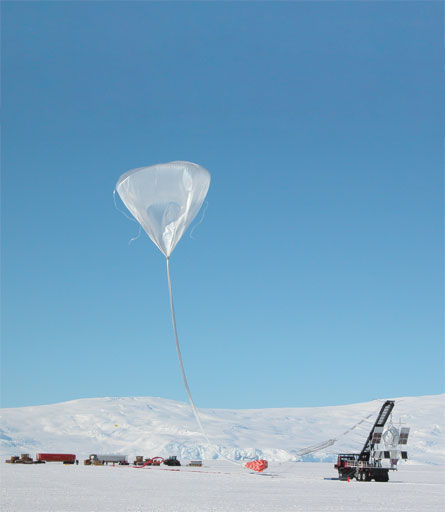
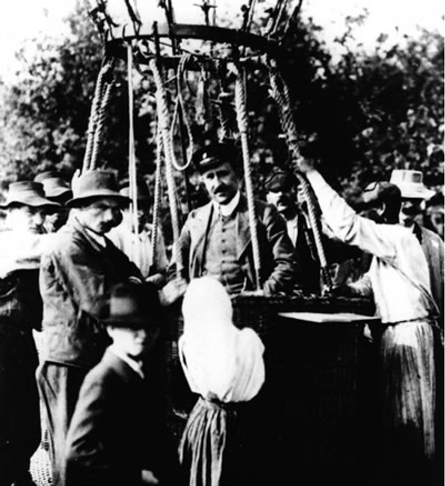
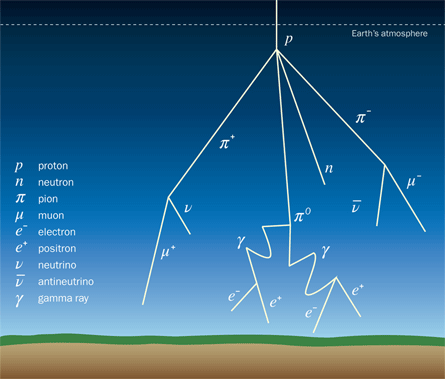
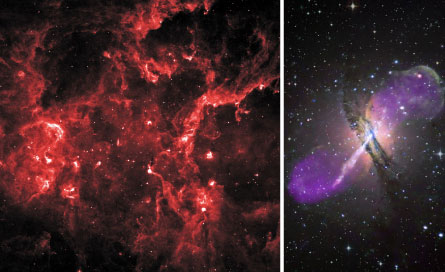
The Austrian physicist climbed aboard a highly combustible, hydrogen-filled balloon, carrying three electroscopes — small, brass-enclosed instruments with metal-coated wires that separate when hit by charged particles. At the time, such invisible ions in the atmosphere were already an aging conundrum, having first been detected in 1785.
His balloon lifted off from the Bohemian town of Aussig. It was just after 6 a.m. Six hours later, having soared to a chilly 5,300 meters, the balloon touched down near Berlin.
Along the way Hess made a discovery that would later earn him a Nobel Prize. His electroscopes recorded three times as many charged particles at an altitude of 4,500 meters as they had on the ground, demonstrating that these particles come from the sky.
Previous experiments with electroscopes underground, underwater and atop the Eiffel Tower had been inconclusive. Some suggested that the charged particles came from the Earth instead of raining down from above. But Hess’ finding that detections increased with altitude proved that the particles weren’t produced in-house. “The results of the present observations seem best explained by assuming that a radiation of great penetrating power enters our atmosphere from above,” Hess concluded in Physikalische Zeitschrift.
In the 100 years since Hess’ flight, scientists have continued to study what became known in the 1920s, somewhat misleadingly, as cosmic rays. They are actually subatomic particles, space travelers slung to Earth from afar. Some come from inside the Milky Way; others, which slam into the Earth with tremendous energies, come from beyond the galaxy. About 90 percent of the rays reaching Earth arrive in the form of energetic protons. Maybe 1 percent are electrons. The rest are heavier atomic nuclei, such as helium or iron.
But that’s about all scientists know for sure.
Coaxing cosmic rays to share their stories hasn’t been easy. With the exception of some lower-energy particles produced during solar outbursts, the rays are surprisingly secretive. Most take circuitous paths to Earth, erasing any trace of the way back home. The most mysterious, called ultrahigh energy cosmic rays, are remarkably scarce and continue to confound scientists. “Whatever is making these rays must be the biggest cannons, the biggest guns,” says astroparticle physicist Peter Gorham of the University of Hawaii at Manoa.
In the effort to find out where exactly cosmic rays come from, powerful detectors now live on land, are submerged in the sea and soar through space. Still, no one knows what astrophysical accelerators hurl these energetic travelers into the void.
“It’s a bit sad that it’s now a hundred years since Hess’ famous balloon flight and we still don’t know where these things come from,” says cosmic ray physicist Alan Watson of the University of Leeds in England.
But cosmic detectives are muscling through. Recent work has crept up on proving beyond a reasonable doubt that supernovas accelerate cosmic rays from within the galaxy. Scientists also have new clues to the chemical composition of the ultrahigh energy rays that journey from farther afield, though the cosmic engine remains unknown. Borrowing from the escapades of yesteryear, a host of balloonborne experiments in the last decade have converged on the frigid Antarctic ice cap — a natural, all-purpose laboratory whose reflectivity might help unveil the anonymous accelerators behind the curtain.
“Scientists ultimately love a mystery,” says James Buckley, an astrophysicist at Washington University in St. Louis. “It’s a good thing if you want to keep building newer and bigger instruments. It’s not like science is failing.”
Pinged from nearby
Cosmic rays arriving from sources within the Milky Way are better understood than their higher-energy brethren. The galactic flavor is common, with about 10 particles passing through a person’s thumb every minute. Fifty times that many would bombard a thumb above the Earth’s atmosphere, which is one reason why prolonged spaceflight can be a risky proposition.
Galactic cosmic rays arrive with anywhere up to a billion billion electron volts of energy, tens of thousands of times the amount produced in proton collisions in the Large Hadron Collider, at the European physics laboratory CERN in Geneva. Most of these rays, though, are somewhat less energetic — between 100 million and 10 billion eV. Since they’re charged, rays at these energies are bounced around by magnetic fields.
“A particle wandering across the Milky Way toward Earth would be taking essentially a drunken walk,” says particle physicist Jasper Kirkby of CERN. “The final arrival direction has absolutely no relation to where it came from.”
That complicates efforts to find the accelerators that send these particles on their way. But scientists think they have a lead on at least one source: supernovas.
“That’s a perfect explanation,” says physicist Francis Halzen of the University of Wisconsin–Madison. “The only problem is, there’s no evidence for that.”
No definitive observational link between incoming particles and faraway stellar explosions has yet been seen, but the proposal does make astrophysical sense. Cosmic rays could easily come out of a turbulent accelerator consisting of supernovas and blustery, giant stars — a chaotic cosmic environment that not only produces particles, but also traps them, shoots them around and eventually kicks them out.
Such places are called superbubbles, and NASA’s Fermi Gamma-Ray Space Telescope recently came close to observationally implicating superbubbles as galactic cosmic ray accelerators.
A telescope looking for gamma rays, a high-energy form of electromagnetic radiation, is a helpful hound in the hunt because gamma rays are produced when cosmic rays interact with the interstellar medium. And gamma rays have no charge. “They do point back to their source,” says Robert Binns, an astrophysicist at Washington University in St. Louis.
A clustering of gamma rays in a suspicious environment might point to a cosmic ray homeland. Such clustering is exactly what the Fermi telescope saw when it peered at the Cygnus superbubble, an enormous star-forming region 4,500 light-years away in the Milky Way.
When imaged, the gamma-ray distribution matched the shape of the bubble’s lumps and cavities, formed by billowing stellar winds. The combination of spent supernovas and spasming young stars, plus the gamma-ray match, offers some of the best evidence yet that these regions act as cosmic accelerators, scientists reported late last year in Science (SN Online: 11/29/11).
Added to this evidence is the fact that heavier elements in galactic cosmic rays are also cooked up in these superbubbles. Like fingerprints, the ratios of different elements — such as iron, nickel and neon — can suggest an origin for cosmic rays. “About 20 percent of the material in the cosmic rays is what I would call superbubble material,” Binns says. “The other 80 percent is most likely normal interstellar material, but much of that is probably accelerated by these massive stars anyway.”
Binns is working on reading the stories these ratios tell, using detectors including one called TIGER, flown on a balloon more than 30,000 meters above the Antarctic surface.
Distant homeland
But supernovas, whether in superbubbles or solo, won’t be the answer to a more stubborn mystery: What mammoth astrophysical accelerators create the cosmic rays that, because of their superhigh energies, must come from outside the galaxy?
A half-century after Hess delivered proof that cosmic rays come from above, scientists received an uninvited guest — a particle with an energy of 100 billion billion eV, millions of times the energy generated by the Large Hadron Collider. In 1962, this particle slammed into an array of detectors in Volcano Ranch, N.M. It wasn’t long before more of these enigmatic particles arrived, and in 1991, a ray with more than three times the energy of the Volcano Ranch particle struck the University of Utah’s Fly’s Eye detector. It became known as the “Oh My God particle.” Such subatomic particles, traveling with energies that had never before been seen, opened a new mystery — that of the ultrahigh energy cosmic ray. Scientists are still seeking a superslinging culprit.
“There aren’t many 50-year-old mysteries in science that have been pounded on as hard as this one and have still not yielded a really solid clue,” Gorham says.
The good news is that unlike their less-energetic galactic cousins, these ultrahigh energy rays aren’t deflected en route, so they do point home. The bad news is that the rays are so rare that scientists haven’t gotten a good look at them.
Early estimates suggested that one of these particles lands in a square kilometer of space just once a century. Newer estimates place that frequency at around three particles per millennium.
To study such rare particles, scientists need enormous detectors. Currently, the Pierre Auger Observatory holds the title of largest array, consisting of 1,600 tanks each containing 12,000 liters of water — a battalion spread out over 3,000 square kilometers. The particle-catching array is located in the Argentinean desert, nestled near the mountains.
“It’s a beautiful place, right up against the Andes, between one and 10 cows per square kilometer,” says Watson, who proposed the observatory along with Nobel physics laureate James Cronin in 1992.
When cosmic particles collide with an atmospheric atom — usually a nitrogen nucleus — they fracture into many smaller particles, producing a cascade called an air shower. These showers rain down over as much as 30 square kilometers, which is why the observatory occupies a plot of land roughly the size of Rhode Island. When the particles hit the water, they produce a bit of light visible to detectors inside. Some of the energy also takes the form of something like dim mini-auroras — ultraviolet light that can be seen by an additional array of 24 fluorescence telescopes.
Once, it seemed an ultrahigh energy engine had been found. In 2007 in Science, the Auger team reported a tantalizing link between incoming particles and active galactic nuclei, the violently churning, supermassive black hole-fueled centers of distant galaxies (SN: 11/10/07, p. 291). Nearly 30 particles neatly lined up with mapped galactic cores — one of two good candidates for the role of accelerator. “I would probably bet on active galaxies,” Gorham says. “A monster black hole is nothing to sneeze at.”
But with more data, the connection disappeared, leaving scientists stumped. Then the mystery deepened.
Newer data from the Auger team suggest that ultrahigh energy rays aren’t mostly protons like their galactic counterparts, but are instead heavier atomic nuclei, such as iron (SN: 7/18/09, p. 8). It almost makes sense: Heavier particles carry more charge and could be more easily accelerated to faster speeds. But it is not yet clear how the findings, published in 2010 in Physical Review Letters, fit with current theories of high-energy particle physics. “It’s the most unexpected result,” Watson says. “We see protons at 1018 eV, but more ironlike particles at higher energies.”
Though perplexing, such a scenario might mesh with another recent puzzling result.
In April, researchers reported in Nature that a detector called IceCube at a South Pole laboratory failed to identify any signs of ultrahigh energy cosmic rays coming from gamma-ray bursts — the other front-runner for the title of super-duper accelerator (SN: 5/19/12, p. 18). Buried beneath the Antarctic ice, the IceCube detector fills a cubic kilometer of space. Like the Auger water tanks, the detector searches for what’s known as Cerenkov radiation — the spark of light produced by particles interacting with water (or ice).
But unlike Auger, IceCube doesn’t look for cosmic rays directly. Instead, it focuses on neutrinos: slippery, shape-shifting particles produced as some of the highest-energy cosmic rays travel through space. Neutrinos, like gamma rays, travel in straight lines and point toward home.
“The problem has been that cosmic rays haven’t given us the answer on where the cosmic rays are accelerated,” Halzen says. “So you try the next thing. Building a [cubic] kilometer neutrino detector is an act of desperation.”
After two years of observations, and more than 300 gamma-ray bursts, the team didn’t see any neutrinos. The frustrating result calls into question the link between gamma-rays bursts and ultrahigh energy cosmic rays, assuming current astrophysical theories are accurate.
If, however, gamma-ray bursts unexpectedly spit out heavier particles, the Auger and IceCube results would fit together, Watson says. Heavier nuclei, like iron, behave differently than protons and produce fewer neutrinos, which could explain why IceCube isn’t seeing a link between gamma-ray bursts and neutrinos. “But we’re a long way from sorting out that puzzle,” Watson says.
Soon, a second large neutrino-detecting array will be joining IceCube at the South Pole. Called the Askaryan Radio Array, this collection of radio antennas is being constructed to detect neutrinos produced when extragalactic ultrahigh energy cosmic rays are accelerated to the point that they interact with the thermal radiation left over from the Big Bang.
Using radio waves instead of light to detect neutrinos has its advantages, Halzen says. The paths of the incoming particles are longer, and the ice is more transparent to the radio bursts than it is to light. Scientists are currently constructing the array, which will have 37 detectors all buried 200 meters beneath the ice, covering 200 square kilometers. “These are really kind of little islands that link together because of the extreme clarity of the ice,” Gorham says.
Back to balloons
The South Pole has been a point of convergence for teams studying cosmic rays over the last decade, thanks to its built-in icy reflector and seasonal winds. While some detectors are buried beneath the ice, others fly far above the frosty landscape in balloons lofted high into the atmosphere by a polar vortex that begins churning sometime around November. Carried by these winds, the balloons circle the icy pole, easily remaining airborne for weeks at a time, a far cry from Hess’ six hours.
“It’s really kind of fun because balloons have been the backbone of cosmic ray research ever since Hess’ flight,” says astrophysicist John Wefel of Louisiana State University in Baton Rouge. “And still today, we’re using them.”
Beyond the longer flights, today’s balloons also fly much higher than Hess’ hydrogen-filled balloon, reaching more than 30,000 meters above the Earth. They’re much bigger, often large enough that an American football field could fit inside. Binns’ TIGER experiment and a proposed follow-up are two of these Antarctic balloon-based escapades. ANITA is another. This experiment detects radio waves produced when high-energy particles fragment into pieces, resulting in a radio pulse. “That radio pulse is then reflected off the ice in Antarctica,” Binns says. “And our experiment is up in the sky with an array of radio antennas looking down at that.”
For eight years, another balloon experiment called ATIC sniffed out levels of high-energy electrons — perhaps an underappreciated galactic cosmic ray species because of their relatively low contribution to the total amount of incoming particles.
But ATIC uncovered something strange: Electrons with 300 billion to 650 billion electron volts pinged the detector too frequently to be explained by conventional astrophysics (SN: 2/28/09, p. 16). The 210 captured particles hinted that something lurking nearby must be shoving them toward the Earth. Later, ATIC-4, a follow-up experiment, confirmed the initial anomaly.
That first paper incited a flurry of wild speculation, including the possibility of a dark matter source. But Wefel offers another suspect: “The most plausible explanation in standard astrophysics seems to be pulsars,” he says, noting that his answer isn’t so simple. While pulsars — rapidly rotating neutron stars — might be able to accelerate particles, there is no easy way for the particles to escape. “How the heck do we get the particles out so they can start floating around?” he says.
Bit by bit, clues for solving this and the larger cosmic ray mysteries are coming in from detectives working in the coldest places on Earth, in desert plains and from data collected by orbiting spacecraft. But questions still swirl around both classes of cosmic rays. Not that scientists are complaining. “It’s a plague that we enjoy having,” Gorham says.
The ultimate answers may come from detectors even bigger than today’s bulked-up cosmic ray hunters. “Auger is 10 times too small,” Watson says of the Argentinean array. “You get toward the end of your career, and you realize that you made it too small. It’s one of the most frustrating things.”
A commitment to building a bigger detector, sending more gadgets into space, perhaps even one day assembling an observatory on the farside of the moon — these are the strategies that scientists hope will push forward the understanding of these most stubborn of astrophysical phenomena.
And for what reason? “Until we find the source, we don’t know what we will learn from it,” Halzen says. “Most likely, we learn astrophysics that’s so extreme we have not seen it anywhere.”
Gorham expresses the motivation behind the ongoing search in another way. “If you knew that somebody on your block had the biggest, most powerful stereo in the neighborhood, and you could hear it every once in a while, pounding away, wouldn’t you want to know more about what the heck it was and who lived there?” he says. “Maybe it’s some famous rock band.”
Patchwork of arrays
Cosmic ray detectors now cover the land, sea and sky, a sign of ongoing efforts to try to understand what’s accelerating these charged particles.
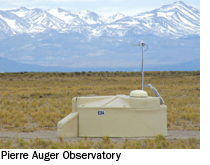 Land: Size matters for modern-day cosmic ray observatories on the ground and buried beneath. Behemoth detectors maximize the chances of catching a ray. The Pierre Auger Observatory in Argentina searches for the highest-energy particles arriving on Earth, using water tanks (one shown) as detectors spread across 3,000 square kilometers. The IceCube Neutrino Observatory, occupying a cubic kilometer of space beneath the South Pole, and the Askaryan Radio Array, which will cover 200 square kilometers when it moves in next door, look for signs of cosmic rays via neutrinos. In the ultimate size exercise, a company called Image Insight is working on an app that will transform anybody’s smartphone into a cosmic ray observatory, allowing an array to spread across the globe.
Land: Size matters for modern-day cosmic ray observatories on the ground and buried beneath. Behemoth detectors maximize the chances of catching a ray. The Pierre Auger Observatory in Argentina searches for the highest-energy particles arriving on Earth, using water tanks (one shown) as detectors spread across 3,000 square kilometers. The IceCube Neutrino Observatory, occupying a cubic kilometer of space beneath the South Pole, and the Askaryan Radio Array, which will cover 200 square kilometers when it moves in next door, look for signs of cosmic rays via neutrinos. In the ultimate size exercise, a company called Image Insight is working on an app that will transform anybody’s smartphone into a cosmic ray observatory, allowing an array to spread across the globe.
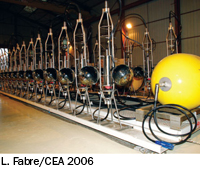 Sea: Whether liquid or frozen, water is useful for detecting cosmic rays. Energetic particles interacting with water produce a spark of light that can be measured — hence Auger’s water tanks. But some scientists have taken that method of detection one step further and submerged entire telescopes. Similar to IceCube in design, the ANTARES neutrino telescope (shown before deployment) lives in the Mediterranean, off the French coast. Not all detectors are so lucky, though. The Baikal Deep Underwater Neutrino Telescope has been submerged for years in the frigid Siberian lake.
Sea: Whether liquid or frozen, water is useful for detecting cosmic rays. Energetic particles interacting with water produce a spark of light that can be measured — hence Auger’s water tanks. But some scientists have taken that method of detection one step further and submerged entire telescopes. Similar to IceCube in design, the ANTARES neutrino telescope (shown before deployment) lives in the Mediterranean, off the French coast. Not all detectors are so lucky, though. The Baikal Deep Underwater Neutrino Telescope has been submerged for years in the frigid Siberian lake.
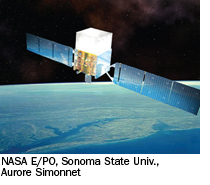 Sky: For another group of cosmic ray detectors, a fear of heights is a definite disadvantage. Some detectors soar tens of thousands of meters up on a balloon, like ANITA or the soon-to-be-launched Super-TIGER experiment. Others hitch a ride through the solar system on spacecraft, including the Cosmic Ray Isotope Spectrometer aboard the Advanced Composition Explorer spacecraft. ACE, launched in 1997, hovers about 1.5 million kilometers from Earth. The Fermi Gamma-Ray Space Telescope (illustration shown), launched in 2008, peers into the high-energy gamma-ray universe from 550 kilometers in altitude. Even closer to Earth is another particle detector, the Alpha Magnetic Spectrometer, that has lived aboard the International Space Station since 2011. It will be joined in a few years by a detector called CALET, hunting for energetic electrons, and a fluorescence detector planned for launch in 2016 that is similar to the array found at Auger.
Sky: For another group of cosmic ray detectors, a fear of heights is a definite disadvantage. Some detectors soar tens of thousands of meters up on a balloon, like ANITA or the soon-to-be-launched Super-TIGER experiment. Others hitch a ride through the solar system on spacecraft, including the Cosmic Ray Isotope Spectrometer aboard the Advanced Composition Explorer spacecraft. ACE, launched in 1997, hovers about 1.5 million kilometers from Earth. The Fermi Gamma-Ray Space Telescope (illustration shown), launched in 2008, peers into the high-energy gamma-ray universe from 550 kilometers in altitude. Even closer to Earth is another particle detector, the Alpha Magnetic Spectrometer, that has lived aboard the International Space Station since 2011. It will be joined in a few years by a detector called CALET, hunting for energetic electrons, and a fluorescence detector planned for launch in 2016 that is similar to the array found at Auger.
In the clouds
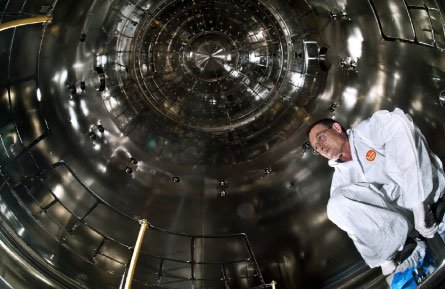 Maximilien Brice/CERN
Maximilien Brice/CERN
Cosmic rays might be doing more than providing fodder for curious scientists. A controversial theory around since at least the 1970s suggests that these energetic charged particles from outer space could play a role in changing Earth’s climate through cloud formation.
The cosmic rays’ effect would fluctuate as the sun moves through its 11-year cycle of magnetic activity. A more magnetically active sun would deflect incoming rays. In principle, cosmic rays interact with vapor particles in the atmosphere to form seeds that can grow into clouds. Fewer rays would mean fewer clouds and higher temperatures.
Now, Jasper Kirkby (shown) of the European physics laboratory CERN in Geneva is using a cloud chamber to determine whether cosmic rays can in fact produce clouds. “It’s quite remarkable to think that events going on millions of light-years away could affect our everyday life, our weather,” Kirkby says. In his cloud chamber, Kirkby carefully assembles an atmosphere from scratch, introducing vapors that live in Earth’s upper atmosphere. After that, Kirkby aims a particle beam of synthetic cosmic rays into the cloud chamber.
Last year, Kirkby and his team reported in Nature that synthetic cosmic rays interacting with sulfuric acid aerosols did lead to the formation of small particles in the atmosphere, though they weren’t big enough to seed clouds. The researchers are currently testing the contributions of additional vapors. Initial results have inevitably added fuel to an already heated debate.
“We have no prejudice,” Kirkby says. “We may find at the end that there’s nothing climatically significant.”